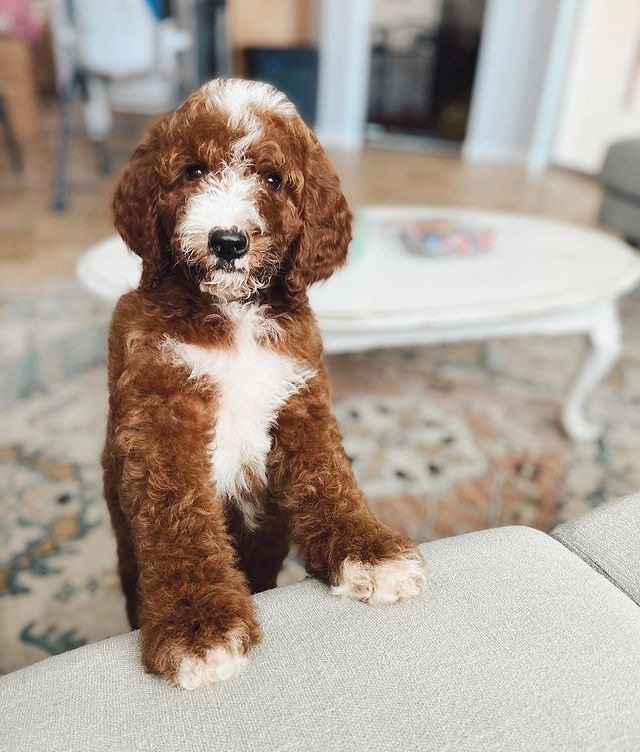
Can Labradoodle puppies tolerate cold temperatures
Can Labradoodle puppies tolerate cold temperatures, or do they need extra protection during winter? This is a common concern for new Labradoodle owners, especially in regions where the temperature drops significantly. While Labradoodles are known for their thick, often wavy or curly coats, the truth is that not all Labradoodles handle cold weather the same way. The answer depends on several factors—age, coat type, size, health status, and the actual temperature.
Understanding how Labradoodle puppies respond to chilly environments can help you make the right decisions—from winter walks and outdoor potty breaks to sleeping arrangements and grooming. If you’re living in a cold climate or planning to bring home a Labradoodle puppy in the winter months, this comprehensive guide will help you keep your pup warm, safe, and healthy.
❄️ Key Takeaways
- Labradoodle puppies can tolerate mild cold, but they are sensitive to harsh winter temperatures and prolonged exposure.
- Puppies under 6 months old, especially with short or thin coats, are more vulnerable to hypothermia and frostbite.
- Proper winter protection includes warm dog coats, boots for icy terrain, indoor sleeping, and limiting time outside.
- Grooming plays a big role in insulation—over-trimming their coat can reduce natural warmth.
- This post includes a long list of Goldendoodle breeders, ideal for families also researching similar hypoallergenic breeds.
How Cold is Too Cold for Labradoodle Puppies?
As a general rule, most healthy Labradoodle puppies can tolerate temperatures above 45°F (7°C) with no significant discomfort. However, when temperatures drop below that threshold, especially under 32°F (0°C), risks start to climb—particularly for younger pups, those with thin or straight coats, and puppies who haven’t fully developed their adult coat yet.
Wind chill, humidity, and wetness all amplify the effects of cold weather. A dry 35°F day might be manageable for a short walk, but a damp, windy one can quickly chill your Labradoodle puppy to the bone.
Age Matters
Puppies younger than 16 weeks are less capable of regulating their body temperature. Even with a fluffy coat, they haven’t developed the metabolic resilience of adult dogs. Therefore, short, supervised outdoor playtime is safer than long walks during frigid weather.
Coat Type and Cold Tolerance in Labradoodles
Labradoodles come in three main coat types—wool, fleece, and hair—each offering a different level of insulation. Their coat type is a huge factor in determining whether they can tolerate cold temperatures comfortably.
- Wool coat: Thick, dense, and curly, offering the most insulation. Labradoodles with this coat resemble Poodles more closely and tend to handle cold better.
- Fleece coat: Silky and slightly wavy, this coat is moderately insulating.
- Hair coat: Straight and often similar to a Labrador’s coat, which is less insulating than the wool variety.
Owners should avoid trimming or shaving a Labradoodle’s coat too short during winter, especially for puppies. A properly maintained, slightly longer coat will help your pup stay warm.
Winter Gear Essentials for Labradoodle Puppies
No matter your Labradoodle’s coat type, additional winter gear can make a big difference in keeping them safe from extreme cold. Puppies, in particular, benefit from layering during icy days.
Must-haves for cold weather:
- Insulated dog jacket: Choose one that covers the neck and belly.
- Waterproof dog boots: Protects from salted sidewalks, ice, and frostbite.
- Reflective collar or vest: Days are shorter; visibility is key during early morning or evening walks.
- Heated or elevated dog bed: Keeps them off cold tile or hardwood floors indoors.
Make sure all clothing fits snugly but isn’t too tight to restrict movement or breathing. Let your puppy wear the items indoors briefly at first to get comfortable before heading outside.
Health Risks of Cold Exposure in Labradoodles
Extended exposure to cold temperatures can lead to health complications in Labradoodle puppies. If you live in regions where snow and freezing rain are common, it’s essential to monitor your pup closely for symptoms of:
- Hypothermia: Lethargy, shivering, weak pulse, stiff muscles.
- Frostbite: Pale or blue-tinted skin on ears, tail, and paws.
- Paw pad injury: Cracking, bleeding, or chemical burns from ice melt products.
Consider keeping a small emergency kit that includes warm blankets, paw balm, and a thermometer. If your Labradoodle appears too cold, bring them indoors immediately and warm them gradually using blankets—not direct heat.
For more insights on orthopedic concerns in small and medium dog breeds that can be worsened by slipping on ice, check this AKC resource.
How to Exercise a Labradoodle Puppy During Winter
One of the main challenges in colder months is ensuring your Labradoodle gets enough exercise. Puppies are bursting with energy, and skipping daily walks due to snow or freezing temps can lead to behavioral issues.
Indoor exercise alternatives:
- Tug-of-war games with a sturdy rope toy
- Hide-and-seek using treats or puzzle toys
- Short indoor fetch sessions
- Climbing stairs or practicing commands
If the weather permits, schedule short, active outdoor sessions during the warmest part of the day, usually between 12–3 p.m. Always towel dry your Labradoodle’s paws and belly after being outside.
Nutritional Support During Winter
Keeping a Labradoodle puppy warm also means fueling their growing bodies. Puppies burn more calories trying to regulate body heat in cold environments.
- Increase protein intake with vet-approved puppy food.
- Provide fresh water frequently, as cold air dehydrates just like hot weather.
- Add supplements such as Omega-3 (ask your vet) to promote a healthy coat for insulation.
A healthy, well-fed Labradoodle will cope with cold weather better and maintain energy throughout winter.
Listicle: Top Goldendoodle Breeders in Cold Climate Regions
If you’re considering a Labradoodle or Goldendoodle and live in a colder region, these top-rated breeders are known for raising puppies well-adjusted to winter conditions.
- Moonlit Acres – Washington State
- Prairie Hill Puppies – Kansas
- Crockett Doodles – Multi-state (focus on colder climates)
- Aladdin Doodles – Central Florida with climate-controlled whelping
- South Carolina Goldendoodles – Winter conditioning programs
- Golden Liberty Doodles – Nevada
- Ashford Manor Goldendoodles – Indiana
- Red Rock Doodles – Utah
- Twin Lakes Doodles – Kentucky
- North Star Doodles – Minnesota
- Jubilee Labradoodles – Oregon
- Sutter Buttes Doodles – Northern California
- Goldenbelle Doodles – Texas
- Teddy Bear Goldendoodles – North Carolina
- SwissRidge Kennels – Ontario, Canada (cold-weather champions)
- Forever Country Doodles – Alabama
- Riverview Doodles – New York
- Red Barn Doodles – Tennessee
- Gracie’s Goldendoodles – Colorado
- Hilltop Pups – Indiana
- Deb’s Doodles – Virginia
- Maple Hill Doodles – Ohio
- Smeraglia’s Teddy Bear Goldendoodles – Alabama
- Southern Skies Doodles – Georgia
- Midwest Goldendoodle – Illinois
Always check that the breeder performs health screenings and offers indoor socialization in winter to properly prepare puppies for cold-weather homes.
Conclusion: Supporting Your Labradoodle Through Winter
So, can Labradoodle puppies tolerate cold temperatures? They can—up to a point. While some Labradoodles thrive in cooler climates thanks to their dense coats, young puppies need extra care, gear, and indoor comfort to stay safe and warm. Understanding coat type, setting up winter-friendly routines, and watching for signs of cold stress can make wintertime enjoyable for both of you.
And remember: proper grooming, nutrition, and exercise routines during cold seasons not only keep your Labradoodle healthy but also foster a deeper bond between you and your furry companion.
For further details on joint health risks heightened by winter conditions, take a look at this helpful AKC article.
🐾 Frequently Asked Question
Can Labradoodle puppies sleep outside during winter if they have a dog house?
No. Even with a well-insulated dog house, young Labradoodle puppies should never sleep outside during winter months. Their bodies are still developing, and they lack the fat reserves and dense coats needed to maintain warmth overnight. Always provide indoor sleeping arrangements, especially when temperatures fall below 45°F.




